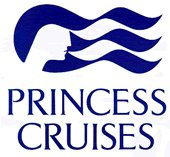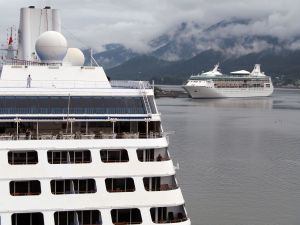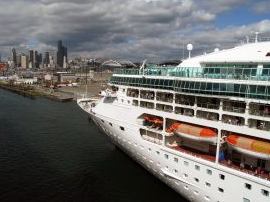 A crew member from a Princess cruise ship was arrested in Los Angeles on Monday after a female passenger accused him of sexually assaulting her during a Panama canal cruise.
A crew member from a Princess cruise ship was arrested in Los Angeles on Monday after a female passenger accused him of sexually assaulting her during a Panama canal cruise.
The suspect, who was identified Wednesday as 38-year-old Manuel Texeira, a Portuguese national, was arrested on March 9 when the Coral Princess berthed in San Pedro, California.
The port, just south of Los Angeles, was the final stop of a 14-day journey which began in Ft. Lauderdale, Florida.
As soon as the ship docked, the FBI boarded and began investigating. The arrest and investigation are under the jurisdiction of the FBI rather than local police, since the alleged attack occurred in international waters two days prior to the conclusion of the cruise.
Julie Benson, a spokeswoman for Princess Cruises, did not specify exactly where the alleged attack occurred, nor how soon after it occurred that the victim reported it.
However, she did say in a statement that as soon as they learned of it, management immediately put in place their “crime response protocol,” which reportedly includes sealing off the crime scene, confining the crew member to his cabin with a security guard, and providing “medical assistance” to the victim.
The statement also did not give details regarding the severity of the attack, nor whether a rape kit is included in the crime response protocol.
Though incidents like this are rarely reported in the media and cruise lines claim that their ships are extremely safe, some experts say that sexual assaults happen more frequently than people think.
 “The industry would like to present an image that sexual assault is uncommon,” said Ross Klein, founder of CruiseJunkie.com and a professor at Memorial University of Newfoundland who studies the cruise industry. “However it is more common than they would like you to believe.”
“The industry would like to present an image that sexual assault is uncommon,” said Ross Klein, founder of CruiseJunkie.com and a professor at Memorial University of Newfoundland who studies the cruise industry. “However it is more common than they would like you to believe.”
Exact statistics are hard to come by because cruise lines are not required to report or even track them. However some light was shed on the topic during a series of congressional hearings in 2007, and during recent legal depositions related to passenger lawsuits in which cruise lines were forced to reveal details of onboard crimes.
Klein has data which show that one cruise line reported 451 cases of sexual assault to the FBI between 1998 and 2005. And in the 12-month period from April 2007 to April 2008, the FBI tracked 169 cases of sexual assault industry-wide.
Of the sexual attacks that were reported, the majority (77 percent) were perpetrated by crew members against guests. About 13 percent were guest-on-guest incidents, 8.5 percent were crew-on-crew incidents, and the remaining 1.5 percent were guest-on-crew.
Klein maintains that these numbers represent just the tip of the iceberg. He cites crime experts who believe that only six percent of sexual assault victims actually report their assault.
“The number of sexual assaults that are reported is dreadfully low by comparison to the number that actually occur,” Klein said.
 Legislation was introduced into Congress last year that would require cruise lines to
Legislation was introduced into Congress last year that would require cruise lines to
track crimes and implement crime scene procedures. The legislation was introduced partly as a result of lobbying efforts of a Sacramento woman who was raped onboard a ship in 2006, then treated dismissively afterwards.
Klein says the increased pressure from Congress seems to have prompted cruise lines to proactively step up to the plate.
“Many companies have increasingly been implementing protocols to handle crime,” Klein said. “But they weren’t doing it two years ago. Many started doing this only very recently. Cruise lines are seemingly becoming more sensitive to the needs of crime victims, and are creating the appearance of being responsible.”
It remains to be seen whether these moves are being made out of genuine concern for passengers, or out of a desire to avoid bad publicity.
Whatever the case, passengers should not get the false impression that a cruise ship is a hermetically-sealed crime-free zone. Most experts estimate that the risk of being assaulted at sea is neither greater nor less than the risk on land.
Passengers should always take steps to ensure their safety when they are on board a cruise ship, as they would at home or at work.
Expensive jewelry and electronics should be left at home or in the ship’s safe, and children, especially teenagers, should be supervised at all times. Klein said that 17 percent of sexual attacks onboard involve minors.
Many crimes are a result of the aggression and/or vulnerability that result from alcohol. Though drinking is one of the most popular cruise ship pastimes, passengers need to limit their intake and always stay on their guard when they are intoxicated. Women in particular should not accept drinks from strangers nor go into someone else’s stateroom if they don’t know them well.
Related links: Los Angeles Times, KABC-Los Angeles, USA Today, Cruisecritic.co.uk
By Karen Elowitt for PeterGreenberg.com.
Read more about cruise safety in our Safety & Security section.
Related articles:












